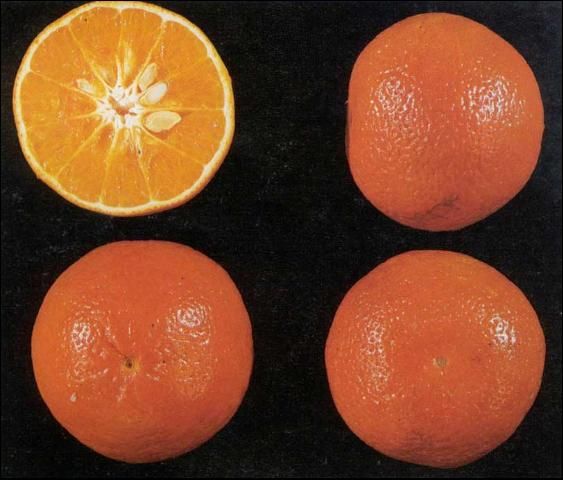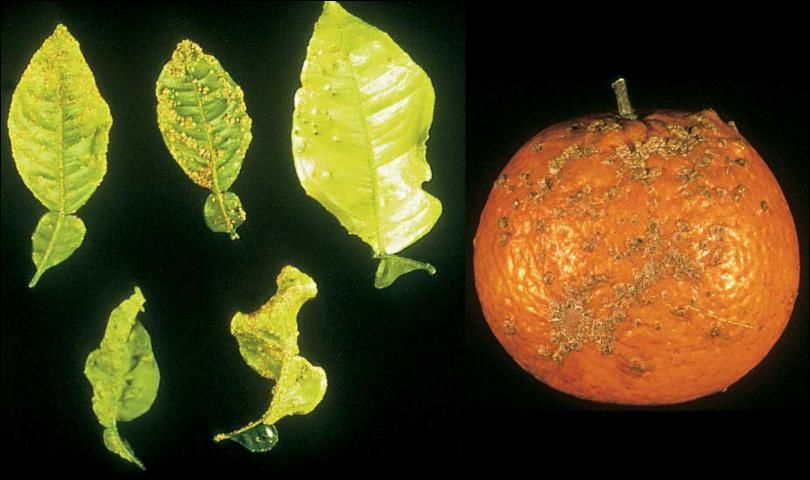The Temple tangor (Figure 1) is most often referred to as an orange, but there is ample evidence to suggest it is actually a tangerine-orange hybrid, or tangor. Apparently the cultivar originated in Jamaica in the late 1800's. It was later introduced into Florida and propagated by Buckeye Nurseries who named the variety Temple in 1919 after the late W. C. Temple who had earlier promoted the fruit in the state. The Temple, with tropical origin, has a relatively high heat requirement and is rather sensitive to cold. It does fairly well under commercial cultivation in Florida and produces very good quality fruit.

Credit: UF/IFAS CREC
Fruit Characteristics
Temple fruit are medium-large, averaging about 2¾-3 inches in diameter. The fruit is slightly flattened in shape and may have a short, wrinkled neck. The rind is fairly thick and relatively easy to remove, with a pebbly or somewhat rough surface. Rind color at maturity is a deep reddish-orange. The flesh is a mild orange color, tender, juicy and rich in flavor. Seeds usually number between 15 and 20 per fruit.
The fruit matures in the January-March period and blemish-free fruit is desired by the gift fruit trade. However, the demand for this variety has greatly declined in recent years. Special care is required in harvesting and handling of this fruit as it is easily damaged. A fully mature, properly handled Temple is a beautiful fruit with excellent eating quality.
Temple fruit is highly susceptible to scab fungus disease (Figure 2) which disfigures the fruit and creasing of the peel is sometimes a problem.

Credit: UF/IFAS CREC
Tree Characteristics
Temple trees are slightly smaller than many other citrus types but tend to be moderately vigorous. The tree is rather bushy, somewhat thorny and has elongated, tangerine-like leaves. Temple has numerous flushes throughout the year which tend to make the tree a target for aphids and psyllids. These flushes and an inability to become quiescent during winter months results in Temple being the most cold-sensitive tangerine-type tree grown in Florida. The tree's cold susceptibility and the later maturity of fruit make Temple a poor choice for colder locations of the state.
Temple has been propagated on many rootstocks but does best on the less vigorous ones, which tend to produce fruit of best quality. All factors considered, Cleopatra mandarin would likely be the best rootstock for Temple and Carrizo citrange and Swingle citrumelo other possible choices. Sour orange should not be used due to possible problems with citrus tristeza virus and as previously stated, vigorous rootstocks should be avoided.
The scab fungus which attacks the fruit will also cause damage to Temple foliage if not controlled.
Cultivation
Temple trees can be counted on to perform much as other citrus trees. Their flowers produce an abundance of pollen and they are often used as pollenizers in blocks of self-incompatible varieties such as Orlando, Nova, and Minneola tangelo and Robinson and Sunburst tangerines.
Field observations have produced some concerns which are reiterated below for grower consideration:
- Temple is scab-susceptible and may require a vigorous spray program during the spring to control this disease of leaves and fruit.
- The cold-sensitivity of Temple is a matter of concern for growers in historically cold locations.
- Frequent growth flushes of Temple often result in aphid and psyllid problems which may necessitate control. The flushes also make scab more difficult to control.
- When delivering Temples to the juice market care should be taken in the transportation to the processing plant. In many cases only a partial load will be delivered as full loads will tend to damage the fruit on the bottom of the trailer resulting in a high cull rate at the processing plants.
- Avoid excessive fertilizer rates, especially nitrogen as the primary market is fresh and high fertility rates might reduce fruit quality. High fertilizer rates tend to slow degreening and increase peel thickness along with increasing course texture of the peel.
More Information
Jackson, Larry K. and Frederick S. Davies. 1999. Citrus Growing in Florida, Fourth Edition. University Press of Florida, Gainesville, FL. pp. 99-100.
Morgan, K.T. and D.M. Kadyampakeni. Nutrition of Florida Citrus Trees, Third Edition. SL253, UF/IFAS Extension. https://edis.ifas.ufl.edu/publication/SS478
Saunt, James. 2000. Citrus Varieties of the World. Sinclair International Limited, Norwich, England. pp 85-86.